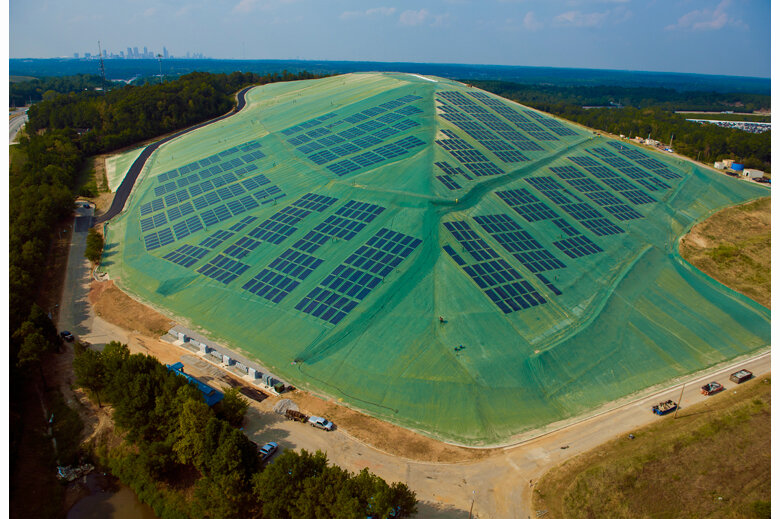
HICKORY RIDGE LANDFILL
PROJECT SCOPE
By using exposed geomembrane solar cap technology, the at-capacity 48-acre Hickory Ridge Landfill was transformed into the largest solar energy generating facility in Georgia. It is the world’s largest solar energy cap and the first use of the technology as a fully permitted landfill final closure system.
This new and innovative technology caps the landfill with an enhanced geomembrane anchoring system developed by HDR – essentially taking a durable, high-strength geomembrane material made for outdoor exposure on roofs and securing it to the landfill like a bedsheet through the use of vertical anchor trenches. The geomembrane-covered landfill sideslopes provide an ideal, clean and stable surface for thin-film photovoltaic solar panels to be directly adhered. The Hickory Ridge Landfill solar energy cover uses over 7,000 solar panels to convert sunlight into more than 1 megawatt of clean, renewable electricity for the owner, Republic Services, and the local community.
The Hickory Ridge Landfill closure represents a milestone in the solid waste industry because it replaces a traditional Subtitle D closure – which covers a geomembrane liner with layers of soil and grass – with an alternative cap system that provides many environmental and economical advantages. The solar energy cover helps avoid thousands of tons of greenhouse gases that would be emitted from the mowing and soil replacement activities needed for long-term care of a grass-covered cap. Because rainwater runs off the geomembrane liner like water coming off a roof into a gutter, reusable water can be harvested without the need for sedimentation and cleaning.
The installation costs of an exposed geomembrane closure are substantially less than a traditional closure. By reinvesting construction and maintenance savings in solar panels, long-term maintenance costs can be replaced with a positive revenue stream.geomembrane closure are substantially less than a traditional closure. By reinvesting construction and maintenance savings in solar panels, long-term maintenance costs can be replaced with a positive revenue stream. The method used for the Hickory Ridge Landfill solar energy cover provides widespread future reuse opportunities. This type of sustainable cap design can also be applied to capping coal combustion product (CCP) for a beneficial reuse of monofills that have reached their capacity and provide them with an opportunity to double as a platform for solar energy generation.
Awards
2012 – Grand Award, Engineering Excellence Awards, American Council of Engineering Companies of Georgia
2012 – Honor Award, Engineering Excellence Awards, American Council of Engineering Companies
2012 – Honor Award, American Academy of Environmental Engineers




